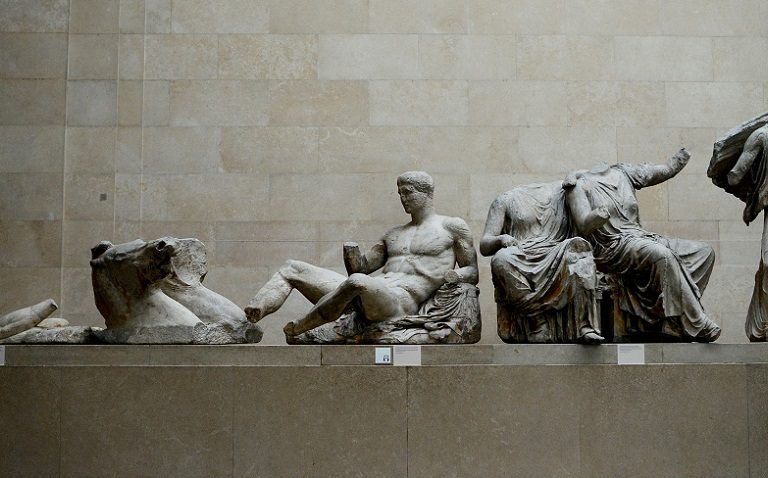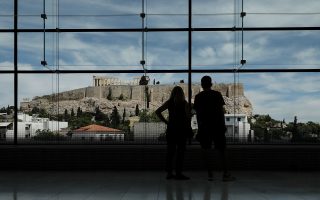Μερικές σκέψεις για τα Ελγίνεια Μάρμαρα και άλλα

Το τελευταίο διάστημα γίνεται πολλή κουβέντα για τα γλυπτά του Παρθενώνα, σε βαθμό που το θέμα έχει πάρει και πολιτική χροιά, με την αξιωματική αντιπολίτευση να είναι στα κάγκελα, μήπως και η παρούσα κυβέρνηση κάνει καμιά έκπτωση και τα μάρμαρα βρεθούν στην Ελλάδα προεκλογικά.
Είπα να γράψω κάτι για το θέμα. Οπως συνηθίζω, πρώτα ρωτάω να μάθω και μετά προσπαθώ να αξιοποιήσω τις πληροφορίες για να διατυπώσω κάποια θέση. Εχω έναν φίλο στο εξωτερικό ο οποίος είναι πρόθυμος να με βοηθήσει σε όλα τα θέματα. Ετσι λοιπόν του έστειλα τρεις ερωτήσεις για το θέμα και πήρα τις απαντήσεις. Λυπάμαι, γιατί ο φίλος μου δεν μιλάει ακόμη καλά Ελληνικά και έτσι τόσο οι ερωτήσεις όσο και οι απαντήσεις είναι στα Αγγλικά. Ζητάω συγγνώμη για όσους δεν θα μπορέσουν να παρακολουθήσουν το κείμενο, αλλά δεν μπορεί να γίνει διαφορετικά.
– What do you know about the Elgin Marbles?
The Elgin Marbles are a collection of classical Greek marble sculptures, insctriptions, and architectural features that once adorned the Parthenon temple on the Acropolis of Athens, Greece. They were removed from the Acropolis by Thomas Bruce, 7th Earl of Elgin, who served as the British ambassador to the Ottoman Empire in the late 18th and early 19th centuries. The marbles were then transported to England and sold to the British Museum in London, where they have been on display since 1817. The removal of the marbles from the Acropolis, also known as the “Elgin Marbles” has been a controversial topic since then. Some argue that they were removed illegally and should be returned to Greece, while others argue that they were removed with the permission of Ottoman authorities and that they are better preserved and more accessible to the public in the Bristish Museum. The debate continues over the rightful ownership and the ethical implications of the removal and the display of the Elgin Marbles.
– What is the best way for Greece to get back the Elgin Marbles?
The best way for Greece to get back the Elgin Marbles is a matter of debate and there are a few options that have been proposed:
Negotiations: Greece could negotiate with the British Museum and the British government for the return of the marbles. This could involve a loan agreement, where the marbles would be temporarily returned to Greece for a certain period of time, or a permanent return.
International pressure: Greece could seek support from other countries, international organizations, and cultural heritage experts to put pressure on the British Museum and the British government to return the marbles.
Legal action: Greece could pursue legal action to claim ownership of the marbles, arguing that they were removed illegally.
Cultural diplomacy: Greece can strengthen their cultural diplomacy and cultural relations with the UK and other countries, to promote the idea of returning the marbles to Greece for the benefit of all to promote the common heritage of all humanity.
It is important to note that the return of the Elgin Marbles is not only a matter of legal or cultural rights, but also a matter of political will. The British Museum and the British government would have to agree to return the marbles, which would require a change in policy or a change in the legal framework.
– What do you know about the efforts of the Greek Government to get the Elgin Marbles back to Greece?
The Greek government has made several efforts to get the Elgin Marbles back to Greece since the early 20th century. These efforts included diplomatic negotiations, legal action, and public campaigns to raise awareness about the issue. In the early 20th century, the Greek government established the Committee for the Restitution of the Parthenon Marbles, which aimed to negotiate the return of the marbles with the British Museum and the British government.
These negotiations did not result in the return of the marbles.
In the 1980s and 1990s the Greek government revived the efforts to get the marbles back, and it has been a consistent campaign theme in recent years. In 2002 the Greek government created the Ministry of Culture’s Directorate for the Restitution of the Parthenon Marbles, which is responsible for coordinating the government’s efforts to get the marbles back. In 2008, the Greek government submitted a claim to the British Museum for the return of the marbles, but it was rejected.
In recent years, the Greek government has continued to press for the return of the marbles through diplomatic channels, such as through its representation at UNESCO and other international organizations. The Greek government have also made use of social media and other communication tools to raise awareness about the issue and to build public support for the return of the marbles.
Πραγματικά εντυπωσιάστηκα από τη γνώση και τη σαφήνεια με την οποία μου διατύπωσε τις απόψεις του για το θέμα. Είμαι βέβαιος ότι κι εσείς θα συμφωνήσετε μαζί μου ότι αν κάναμε τις 3 αυτές ερωτήσεις στους 300 της Βουλής μας, πολύ λίγοι θα μας έδιναν τόσο ξεκάθαρες απαντήσεις για το θέμα. Αν δε ρωτούσαμε τους νέους μας, που συνεχώς τους κανακεύουμε, ακούγοντας τις απαντήσεις θα θέλαμε να αυτοκτονήσουμε.
Σας ξεγέλασα! Οι απαντήσεις δεν έγιναν από άνθρωπο, αλλά από ένα λογισμικό τεχνητής ευφυΐας, που είμαι απολύτως βέβαιος ότι θα αλλάξει τη ζωή μας στο μέλλον. Πρόκειται για το CHATGPT, το οποίο ακόμη διατίθεται δωρεάν και βρίσκεται στα τελευταία στάδια της εμπορικής εκμετάλλευσής του. Διάλεξα ένα δύσκολο θέμα για να αναδείξω την αποτελεσματικότητά του. Σας πληροφορώ ότι έδωσα μόνο τις τρεις ερωτήσεις και πήρα αυτές ακριβώς τις απαντήσεις, τις οποίες δεν αλλοίωσα. Είναι δύσκολο να πιστέψει κανείς ότι το κείμενο προήλθε από μηχανή. Δοκιμάστε το στο chatgpt.pro. Θα εκπλαγείτε.
Μια σημαντική σημείωση. Η παρούσα έκδοση του chatgpt δεν περιλαμβάνει γεγονότα και γνώση του 2022 γιατί ακόμη δεν έχει ενσωματωθεί. Ετσι, αν δεν περιλαμβάνει τις εξελίξεις του 2022 για τα Γλυπτά δεν είναι έλλειψη ή λάθος.
Θέλοντας να πάω ένα βήμα παρακάτω, για να σας δώσω ένα ελαφρότερο παράδειγμα, του ζήτησα να μου γράψει ένα ποίημα για τον έρωτα και τα νιάτα, αυτά δηλαδή που μου λείπουν. Ιδού το αποτέλεσμα. Δεν πάει για βραβείο ούτε συγκρίνεται με τα μοναδικά γρήγορα ποιήματα του Λευτέρη Παπαδόπουλου, που έγραφε για τους φίλους του, αλλά δεν είναι καθόλου κακό.
– Write a poem about love and youth
With youth in our hearts and love in our souls,
We chase dreams like stars, never growing old.
Love is warm like the sea and life itself,
It ignites us, making us feel brand new, nothing else. With each step we take, we learn and grow,
Falling in love, our hearts overflow.
Youth and love, a perfect pair. Together they take us everywhere.
In the warmth of love, youth will never die,
Our hearts beating fast, reaching for the sky.
Let us embrace each moment, make it last,
For in love and youth, forever we’ll be cast
Πάει, αχρηστεύθηκε και ο Cyrano de Bergerac, που έγραφε ερωτικά γράμματα και ποιήματα για άλλον, ώστε να ρίξει τη Roxane. Τον ξεπέρασε ένας computer!
Υ.Γ.: Το 1966 οι Times του Λονδίνου έκαναν έναν διαγωνισμό για τον πιθανό τίτλο που θα μπορούσε να έχει η εφημερίδα το έτος 2000. Τον διαγωνισμό τον κέρδισε ο τίτλος: «Government Computer Resigns». Είμαι βέβαιος ότι σε μερικά χρόνια θα το δούμε και αυτό.
* O κ. Ανδρέας Δρυμιώτης είναι σύμβουλος επιχειρήσεων.
** Το άρθρο δημοσιεύτηκε αρχικά στην Καθημερινή της Κυριακής.
 Ακολουθήστε το Money Review στο Google News
Ακολουθήστε το Money Review στο Google News




